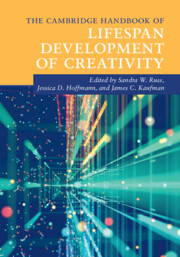Book contents
- The Cambridge Handbook of Lifespan Development of Creativity
- The Cambridge Handbook of Lifespan Development of Creativity
- Copyright page
- Dedication
- Contents
- Figures
- Tables
- Contributors
- Acknowledgments
- Introduction
- Part I Core Concepts of Lifespan Creativity Development
- Part II The Development of Creativity
- 5 Are Preschoolers Creative?
- 6 Development of Creativity in School-Age Children
- 7 The Development and Enhancement of Adolescent Creativity
- 8 The Intertwined Development of Identity and Creativity
- 9 Creative Development in Children from a Measurement Perspective
- 10 Creativity in Adulthood
- 11 The Many Faces of Creativity in Old Age
- Part III Modes of Enhancement
- Part IV Environments and Contexts
- Part V Special Populations
- Index
- References
8 - The Intertwined Development of Identity and Creativity
Immersing in the Digital Self
from Part II - The Development of Creativity
Published online by Cambridge University Press: 19 November 2021
- The Cambridge Handbook of Lifespan Development of Creativity
- The Cambridge Handbook of Lifespan Development of Creativity
- Copyright page
- Dedication
- Contents
- Figures
- Tables
- Contributors
- Acknowledgments
- Introduction
- Part I Core Concepts of Lifespan Creativity Development
- Part II The Development of Creativity
- 5 Are Preschoolers Creative?
- 6 Development of Creativity in School-Age Children
- 7 The Development and Enhancement of Adolescent Creativity
- 8 The Intertwined Development of Identity and Creativity
- 9 Creative Development in Children from a Measurement Perspective
- 10 Creativity in Adulthood
- 11 The Many Faces of Creativity in Old Age
- Part III Modes of Enhancement
- Part IV Environments and Contexts
- Part V Special Populations
- Index
- References
Summary
Is identity formation a “discovery” or a “creation”? In contemporary Western views, the latter seems to win this classic debate. After outlining how identity may be viewed as both a creative process and product, this chapter addresses several levels across which creativity and identity development are intertwined. To illustrate the dynamic relationship between both constructs, an underlying thread of this chapter focuses on the opportunities digital worlds give us to explore and express our identity, and, reciprocally, how our experiences in digital worlds – in particular the embodiment of “alternative” selves through immersive virtual reality – can transform our view of ourselves and the world around us. These new ways to “create our identity” bring about new fundamental questions concerning the way future generations will navigate their developmental tasks. Directions to embrace these digital realities for the betterment of human development are discussed.
- Type
- Chapter
- Information
- The Cambridge Handbook of Lifespan Development of Creativity , pp. 159 - 175Publisher: Cambridge University PressPrint publication year: 2021
References
- 1
- Cited by

